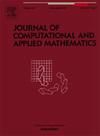Mixtures of common factor analyzers using the restricted multivariate skew-t distribution for clustering high-dimensional data with missing values
IF 2.1
2区 数学
Q1 MATHEMATICS, APPLIED
Journal of Computational and Applied Mathematics
Pub Date : 2025-05-11
DOI:10.1016/j.cam.2025.116708
引用次数: 0
Abstract
Mixtures of common restricted skew- factor analyzers (MCrstFA) have emerged as a parsimonious and practical approach for the model-based clustering of high-dimensional data with asymmetric features and outlying observations in one or more heterogeneous populations. However, missing data has become a ubiquitous problem that frequently adds complexity to the analyses for practitioners. Most existing tools are not adaptable to data with missing values, which is a significant reason for this complexity. This paper proposes an extension of the MCrstFA framework that allows the analyst to parsimoniously model data with missing values, skewness, heavy tails, and multimodality simultaneously. Under the missing at random (MAR) mechanism for nonresponses, a computationally feasible expectation conditional maximization either (ECME) algorithm is developed for computing maximum likelihood (ML) estimates of model parameters. The estimation procedure enables the automatic imputation of missing values and the prediction of unobserved factor scores. To assess the precision of the ML estimators, an information matrix-based approach is employed to approximate the asymptotic covariance matrix of the estimators. Numerical results obtained from the analysis of simulated and real datasets illustrate the effectiveness of the proposed methodology.
使用限制多变量偏t分布的共因子分析混合聚类具有缺失值的高维数据
常见限制性偏t因子分析(MCrstFA)的混合已成为一种简洁实用的方法,用于在一个或多个异质群体中具有不对称特征和外围观测值的高维数据的基于模型的聚类。然而,数据缺失已经成为一个普遍存在的问题,经常增加从业者分析的复杂性。大多数现有工具都不能适应缺失值的数据,这是造成这种复杂性的一个重要原因。本文提出了MCrstFA框架的扩展,该框架允许分析人员同时简化具有缺失值、偏度、重尾和多模态的数据模型。在无响应的随机缺失(MAR)机制下,提出了一种计算可行期望条件最大化算法(ECME)来计算模型参数的最大似然估计。估计过程可以自动插入缺失值和预测未观察到的因素得分。为了评估机器学习估计量的精度,采用了一种基于信息矩阵的方法来逼近估计量的渐近协方差矩阵。仿真和实际数据集的数值分析结果表明了所提方法的有效性。
本文章由计算机程序翻译,如有差异,请以英文原文为准。
求助全文
约1分钟内获得全文
求助全文
来源期刊
CiteScore
5.40
自引率
4.20%
发文量
437
审稿时长
3.0 months
期刊介绍:
The Journal of Computational and Applied Mathematics publishes original papers of high scientific value in all areas of computational and applied mathematics. The main interest of the Journal is in papers that describe and analyze new computational techniques for solving scientific or engineering problems. Also the improved analysis, including the effectiveness and applicability, of existing methods and algorithms is of importance. The computational efficiency (e.g. the convergence, stability, accuracy, ...) should be proved and illustrated by nontrivial numerical examples. Papers describing only variants of existing methods, without adding significant new computational properties are not of interest.
The audience consists of: applied mathematicians, numerical analysts, computational scientists and engineers.

 求助内容:
求助内容: 应助结果提醒方式:
应助结果提醒方式:


